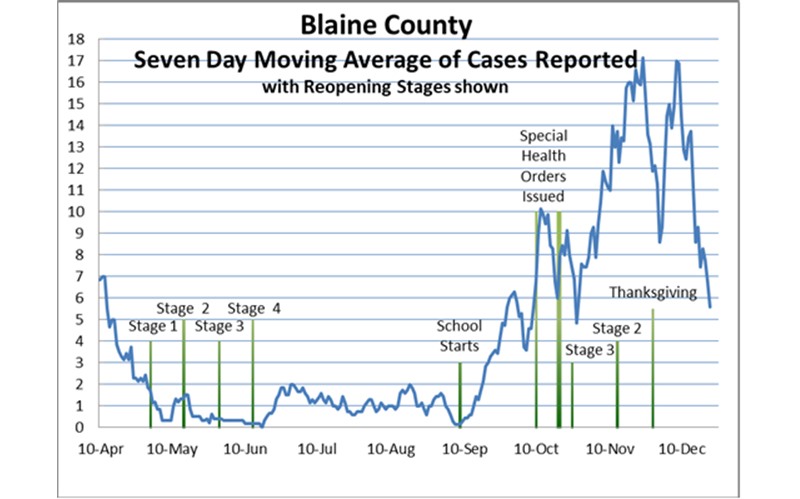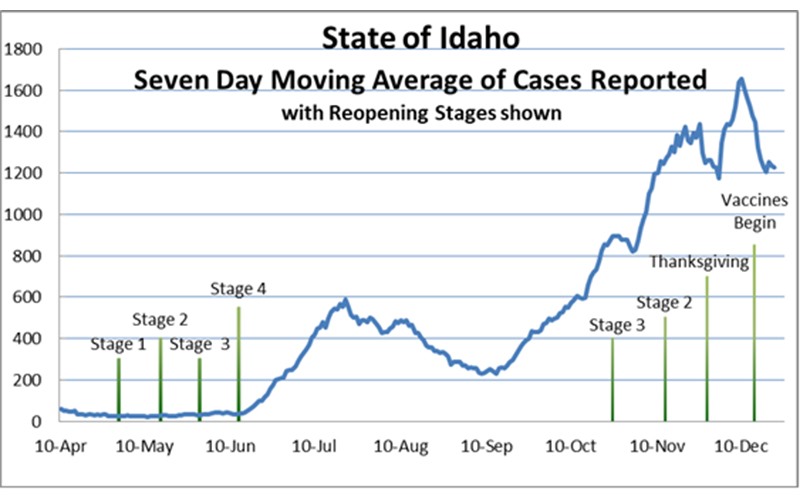|
BY KAREN BOSSICK COVID GRAPH BY PAUL RIES Two Idaho healthcare workers have experienced severe allergic reactions after receiving the Pfizer-BioNTech COVID-19 vaccine. One worker hails from the Treasure Valley; the other from northern Idaho. One is hospitalized in stable condition but is expected to be discharged today; the other has recovered fully.
|
|

Blaine County reported just one new case of coronavirus on Tuesday for a total of 1,533, after notching no new cases on Monday.
|
|
|
Both had a known history of severe reactions after receiving an injectable medication. “The CDC considers a history of severe allergic reaction such as anaphylaxis to any vaccine or to any injectable therapy, as a precaution but not contraindication to vaccination,” said Dr. Christine Hahn, medical director for the Division of Public Health. “In light of these events, we are concerned about the risk to people with such a history and recommend that anyone with a history of severe reaction or anaphylaxis to any vaccine or injectable therapy defer taking this vaccine until more is known.” Hahn said the state will continue to follow the cases. In the meantime, she’s encouraging people without a history of severe reaction or anaphylaxis to a vaccine or injectable therapy to get the vaccine when it’s available for them. The data from clinical trials of the Pfizer-BioNTech vaccine indicate there is very little risk to a vast majority of people who will receive the COVID-19 vaccine. However, there are side effects to the vaccine because it stimulates the body’s immune system. So far, those side effects have included fever, fatigue, headache, chills, soreness at the injection site, among others. They usually don’t last longer than a day or two.
|
|

Idaho reported 1,717 new cases of coronavirus for a total of 132,594 cases. The state lost 12 more Idahoans for a total of 1,313 deaths. So far 5,665 vaccine doses have been administered in the state.
|
|
|
Here are the ingredients in the Pfizer’s COVID-19 vaccine, according to a letter to the Food and Drug Administration. They are considered pretty standard items for a vaccine.
- 30 mcg of a nucleosidemodified messenger RNA (modRNA) encoding the viral spike (S) glycoprotein of SARS-CoV-2.
- lipids (0.43 mg (4-hydroxybutyl)azanediyl)bis(hexane-6,1-diyl)bis(2-hexyldecanoate), 0.05 mg 2[(polyethylene glycol)-2000]-N,N-ditetradecylacetamide, 0.09 mg 1,2-distearoyl-sn-glycero-3- phosphocholine, and 0.2 mg cholesterol)
- 0.01 mg potassium chloride
- 0.01 mg monobasic potassium phosphate
- 0.36 mg sodium chloride
- 0.07 mg dibasic sodium phosphate dihydrate
LEGISLATURE STARTS UP JAN. 11 The Idaho legislature will go on according to schedule, despite concerns raised by Sen. Michelle Stennett and even Gov. Brad Little about the risk of meeting in-person so soon during the coronavirus pandemic.
Some safety measures are being implemented, and the public will be allowed to testify remotely in some cases. Plexiglass shields will be mounted on the desks of lawmakers who ask for it, and hand sanitizer and masks will be available. Seating in committee rooms has been reconfigured to provide physical distancing. WE’RE NO. 2 Idaho has the second highest test positivity rate in the country according to the latest White house Coronavirus Task Force report. Positivity rates exceed 20 percent in 18 of the state’s 44 counties.
The Gem State is also seventh highest in the country for the number of new cases, with 629 new cases per 100,000 population compared with the national average of 451 per 100,000. REFUSING COVID CASES Some medical clinics in the Treasure Valley refused COVID-19 tests to those who wanted a test before heading out of town for the holidays. Refusing tests makes a statement that traveling for the holidays is not a good idea, they say. And it preserves tests for those who need them because they are ill. CRACKING THE CODE
Experts estimate it will take nearly a month for a one-dose vaccine like Johnson & Johnson’s to crack the code and build enough immunity in the vaccinated. Each person is different. The very young and very old have trouble reaching the same antibody levels that those in the middle do, according to Otto Yang, a professor of medicine in infectious diseases and immunology at the David Geffen School of Medicine at UCLA. Immune-compromising health conditions such as end-stage renal disease can also impact how quickly a person’s body builds immunity after receiving a vaccine, Otto told HuffPost. LET LED LIGHTS KILL CORONAVIRUS
Scientists at Tel Aviv University say that LED lights that throw out ultraviolet light can kill coronaviruses and could be incorporated into air conditioning systems to sterilize rooms. In less than 30 seconds 285 nm light destroyed 99.9 percent of all virus pathogens, said the study published in the Journal of Photochemistry and Photobiology. Researchers said 265 nanometers light waves were most effective. KNUFFELING IN BELGIUM Faced with a terrifying numbers of coronavirus cases, Belgium instituted a knuffelcontact. Every person can designate one cuddle contact who is allowed to come over and knuffel, or not, for a short period of time. Those who live alone can designate two knuffel contacts, but they can’t both come over at the same time. A TOUCH OF IMMUNITY?
A new study shows that cellular cells, or T-cells, are likely to be present within most adults six months after infection. Research by the U.K. Coronavirus Immunology Consortium found a robust T-cell response to the coronavirus six months after infection. The response was larger for those who experienced symptoms versus those who were asymptomatic. DON’T PUT A COW IN A ZOOM MEETING In a bad sign for Zoom meetings, new research from the University of Veterinary Medicine in Austria suggests that cows are more relaxed after being spoken to directly by a live human rather than listening to a recorded voice on loudspeaker.
Cows are skilled co-moo-nicators, says a CNN report describing the research. They make distinctive sounds depending on if they’re excited, lonely, looking forward to a meal or talking with their calves. They know their names and calls to go to the milking shed. And they prefer handlers who talk gently, rather than shouting.
|